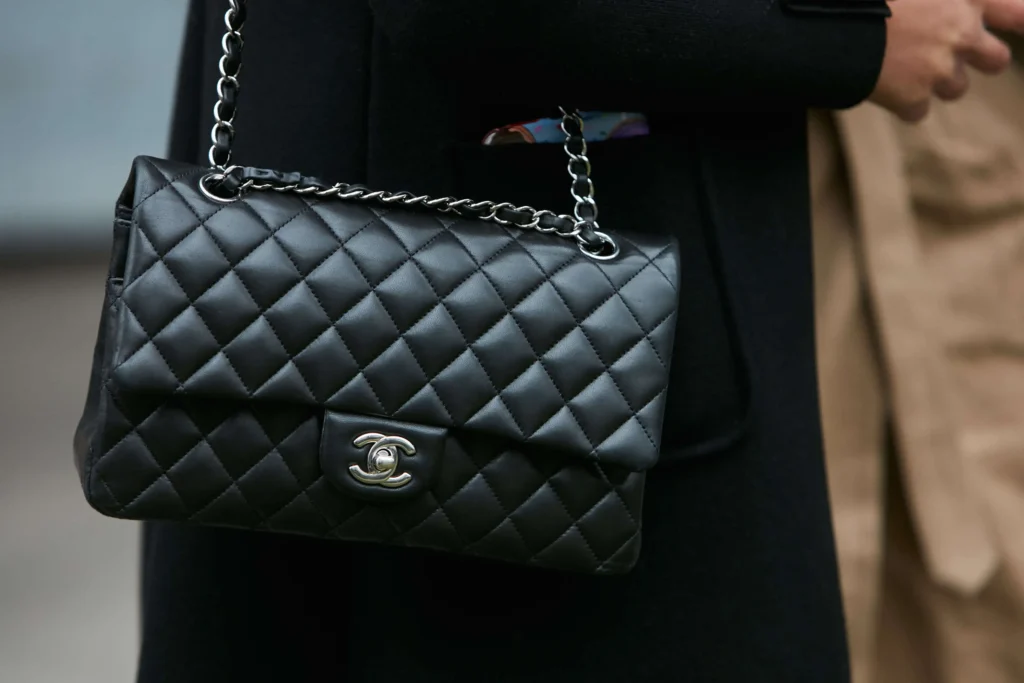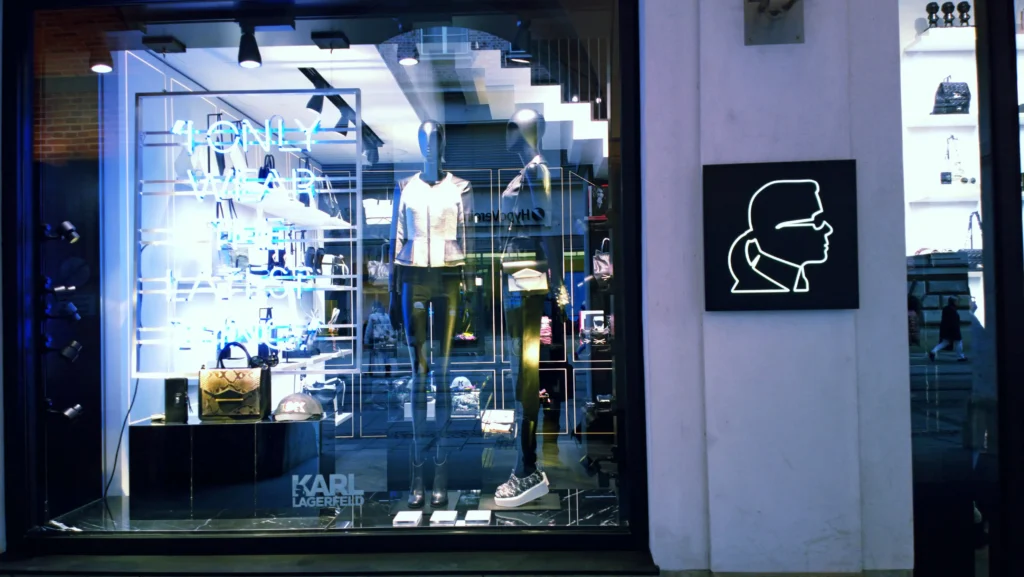Summary
- Karl Lagerfeld was a renowned designer whose work transformed high fashion.
- His visionary designs and creativity continue to have a lasting influence.
- Get inspired and start your next big creation with the Audaces360 multisolution!
Karl Lagerfeld, also known as the “Kaiser”, was a German designer whose legacy stretched beyond the industry. He revolutionized fashion by making it more accessible and reinventing brands like Fendi and Chanel.
He reached the status of pop culture icon, fueled by public appearances in his signature look — white hair in a ponytail, black sunglasses, fingerless gloves, and high-collared shirts.
The designer’s life and career were celebrated in the 2023 edition of the Met Gala, considered by many the most prominent fashion event, and tributes to his work are continuously made all over the world.
Let’s dive into his life and contributions!
Sumário
Who was Karl Lagerfeld?

Karl Lagerfeld built his way to success as an incredibly talented fashion designer with a bold vision and innovative approach, leaving a significant impact on every brand he worked with.
Admittedly inspired by pop culture, he became famous for transforming fashion shows into big spectacles and featuring high-profile models and actresses in his shows and campaigns.
Creating modern and sometimes even commercial collections was one of his strategies to make fashion more accessible and relevant, while staying loyal to his haute couture heritage.
He started his career when he won a design competition and was hired as an assistant by Pierre Balmain, already a renowned high fashion house, in 1955.
Three years later, he moved on to work with designer Jean Patou.
Despite initial criticism for his first collections being “too commercial” and “lacking innovation”, his unique designs later took him to the most prestigious labels.
Where is Karl Lagerfeld from?
Karl Lagerfeld was born in Hamburg, Germany in 1933. However, he moved to Paris at a young age, around 14, to pursue a career.
The city became his base, shaping both his life and career. This early move undoubtedly contributed to his strong association with French fashion.
Learn more: Why does fashion innovation drive the market? 7 trends to consider

Which brands did Karl Lagerfeld design for?
Throughout his illustrious career, Karl Lagerfeld contributed to various famous brands. Here’s a list of the most notable ones:
Tiziani
After leaving the creative direction of Jean Patou, Karl Lagerfeld established himself as one of the first freelancers in the fashion industry.
One of these collaborations was with the Italian label Tiziani, which created iconic red carpet looks for celebrities like Elizabeth Taylor.
Chloé
Karl Lagerfeld had two moments at Chloé: from 1964 to 1983 and from 1992 to 1997.
The highlights of his contributions include the late 1960s and early 1970s, when he introduced a romantic and bohemian aesthetic that lasts until today.
Later, in the 1980s, he created structured silhouettes and incorporated masculine elements into his designs.
His spring/summer 1984 collection became iconic for defying the era’s conventions. During the runway show, models presented delicate silk dresses combined with sneakers and sunglasses in evening looks.
Learn more: Uncover the benefits of fashion trend forecasting for your clothing business
Fendi
In 1965, the German designer began his long-standing relationship with Fendi as its head ready-to-wear designer, while still collaborating with Chloé and other brands as a freelancer.
Proving his talent and energy, he simultaneously managed multiple creative roles throughout his entire career.
With his innovative thinking, he transformed the Italian brand into a global luxury powerhouse recognized for its fashion, craftsmanship, and iconic status.
Karl Lagerfeld designed the famous “FF” logo and produced more than 100 collections over 54 years.
Chanel
Karl Lagerfeld became the creative director of Chanel in 1983, when the brand was in decline and had lost some of its relevance.
His first collection contained various elements of the brand’s 1920s and 1930s designs and was considered a true tribute to the founder Coco Chanel.
While leading the brand, he revisited and reinterpreted iconic garments. He would also often make references to pop culture and contemporary themes.
He was responsible for reinventing the brand’s double “C” interlocking, a symbol that has become synonymous with the brand.
Learn more: Explore the fashion future demands and anticipate what’s next in the market
What were Karl Lagerfeld’s most famous designs?
The legendary fashion designer left an indelible mark on the world of haute couture. His creative genius spanned decades, and he created numerous iconic designs.
Let’s explore some of the most memorable:
Chanel classics’ reinterpretation

A multitude of elements from Coco Chanel’s era were usually reimagined by the Kaiser.
- Quilted handbags: created by Coco Chanel and reinvented several times by Karl Lagerfeld, the items are usually crafted from lambskin and take the signature diamond quilting pattern. The most famous models are the Classic Flap and the Boy Bag.
- Pearl Necklace: Chanel’s founder was known for wearing layers of pearl necklaces, and Karl Lagerfeld incorporated it into his collections, modernizing the accessories with the double “C” logo.
- Tweed jacket: adapted for modern women, this ultimate symbol of luxury and status was included in many collections with slight changes. The tweed material was also explored in dresses, suits, bags, and accessories.
The little black dress
His designs for this wardrobe essential often featured clean lines and unexpected details. The most luxurious versions are red carpet favorites for celebrities.
Learn more: A step-by-step guide on how to draw a dress from scratch
Chanel Hula Hoop bag
Presented in the spring/summer 2013 runway show, the oversized, circular bag made of quilted leather, true to its name, resembled a giant hula hoop. The unconventional accessory sent shockwaves through the fashion world.
Modernization of fur design
When Karl Lagerfeld took the helm at Fendi, the brand was primarily known for fur. He aimed to evolve beyond the traditional, sometimes dated, look of fur items.
He embraced innovative techniques like laser cutting and dyeing, creating fur garments with more texture, movement, and unexpected colors.
Fendi Baguette bag
Originally designed by Silvia Venturini Fendi, it was renewed under Karl Lagerfeld’s influence. In each season it could be seen in new colors, patterns, and embellishments.
Celebrity endorsement was also a strategy used to keep it fresh for a contemporary audience.
What is Karl Lagerfeld known for?
It is a fact that Karl Lagerfeld was a fashion designer and creative director of many fashion houses, helping modernize the industry and make it more accessible.
Here are some more innovative achievements that helped immortalize his legacy:
Modernization of Chanel
When Karl Lagerfeld joined Chanel as creative director in 1983, the fashion house was struggling financially, and he took on the challenge of revitalizing it.
Through a complete modernization of the brand, he restored the relevance of the iconic French brand and re-established the legacy left by Coco Chanel, who died in 1971.
This fresh vision kept Chanel relevant and exciting for a new generation, solidifying its position as a fashion powerhouse.
Spectacular runway shows and sets
While leading the design for Chanel, he became famous for creating elaborate and immersive sets that served as stunning backdrops for the brand’s runway shows.
We’ve selected the most remarkable:
- Spring/Summer 2019 Ready-to-Wear: he and his team brought a beach to life, transforming the runway into a complete beach scene. They recreated an ocean horizon and even functioning waves.
- Fall/Winter 2014/2015 Ready-to-Wear: replicating a supermarket, the set instantly became a social media sensation. It featured shelves packed with fake products while models shopped for groceries wearing luxury clothes from the collection
- Fall/Winter 2017/2018 Ready-to-Wear: Karl Lagerfeld created a meticulously detailed replica of a launch pad, full of details, with a rocket decorated with Chanel’s logo that “lifted off” at the end of the show.
- Fall/Winter 2017/2018 Haute Couture: an incredible scale replica of the Eiffel Tower was built as the centerpiece of the set.
- Spring/Summer 2018 Haute Couture: Chanel’s team transformed the Grand Palais in Paris into a magnificent garden, filled with flowers and a functioning fountain.
Collaborations with fast fashion brands
He was the precursor of collaborations between high-end designers and fast fashion retailers. In 2004, he signed a collection in collaboration with H&M with clothes for men and women.
It was a massive success, and he opened the way for other famous designers to do the same.
In 2016, he designed a 75-piece collection for the Brazilian fast fashion chain Riachuelo. “Brazil is fun, full of energy and a country of the future,” Karl Lagerfeld said at the time.
Publications and books about his career
Karl Lagerfeld was passionate about photography and was also a book collector, having his house full of them and publishing some of his own.
His life was often the theme of publications and through them, it is possible to know more about his eccentric personality:
- “The World According to Karl”: a collection of quotations about fashion, art, politics, love, and life in general.
- “Choupette: The Private Life of a High-Flying Fashion Cat”: this book, divided into thematic chapters, including diet, beauty, healthcare, and fashion tips, is all told from the perspective of Karl’s beloved cat.
- “Karl Lagerfeld: A Fashion Journal”: the publication reunites watercolor, pencil, and ink drawings that he made over thirteen years.
Creating his own brand

In addition to his work with Fendi and Chanel, in 1984 he launched his own label — Karl Lagerfeld.
With this, he was able to put even more of his personality and style into creation. Oversized fit, monochrome figures, and constant homages to his cat Choupette were characteristics of the brand.
Aligned with his philosophy of making fashion accessible, the brand continues to offer high-quality, trendy garments at a more attainable price point compared to the luxury labels he previously designed for.
It also caters to a younger audience, blending Parisian elegance with a touch of youthful energy.
What was the relationship between Karl Lagerfeld and technology?
Karl Lagerfeld’s forward-thinking approach led him to embrace technology throughout his career. This began as early as the 1960s when he used lasers to modernize furs at Fendi.
His commitment to innovation extended to Chanel’s fashion shows, where he created groundbreaking and disruptive sets using technology.
He further employed augmented reality in a Chanel collection display, allowing customers to explore the items through a blend of the physical and digital worlds.
Learn more: What is phygital fashion and how to integrate the physical and digital in apparel
Get inspired by Karl Lagerfeld and create with excellence!
Creativity and design references are essential to create innovative collections that meet market demands. To help you bring your ideas to life, technology can be a great ally.
It enables the reproduction of colors, details, fit, and movement of garments with ease. Plus, they can even spark inspiration when you hit a creative block.
Check out the tools of Audaces360 that can help take your designs to the next level!
Audaces Fashion Studio
You can imagine how much you want, Audaces Fashion Studio will make it possible. This solution was developed to create 3D drawings relying on various tools and possibilities.
Enhance the agility and quality of your designs with this cutting-edge technology!
It allows you to simulate garments on a three-dimensional mannequin, experimenting with colors, textures, and prints with unparalleled ease.
Achieve perfect color accuracy and ensure a flawless fit with advanced simulation tools, simplifying the entire design workflow.
Audaces Idea
Manual drafting days are over. Audaces Idea empowers you to create detailed and accurate technical drawings with ease.
With just a few clicks, you can apply prints to your digital drawings, quickly visualizing your creations.
Not only can you ease design, but you can also calculate the pre-cost of your garment samples and tech packs right within the same platform.
This eliminates the need for time-consuming manual calculations and ensures you stay on top of production costs from the very beginning.
Audaces Sofia
Audaces Sofia is a revolutionary fashion design software powered by cutting-edge Artificial Intelligence (AI). This solution is your intelligent design partner, always ready to empower you and assist in your creative process.
It analyzes your commands and utilizes its database of fashion trends, styles, and materials to generate design options tailored to your vision.
Stop waiting for inspiration to strike. With Audaces Sofia, you have the power to unlock your full creative potential and transform your designs.
Get to know other famous designers by downloading our free e-book!
FAQ
Karl Lagerfeld built his way to success as an incredibly talented fashion designer with a bold vision and innovative approach, leaving a significant impact on every brand he worked with.
Tiziani, Chloé, Chanel, and Fendi.
Chanel classics’ reinterpretation, the little black dress, Chanel Hula Hoop Bag, modernization of fur design, and Fendi Baguette bag.











2 Responses
The Legend💙💋an Awesome Man
Absolutely! He was an iconic designer and will forever be remembered in fashion history.